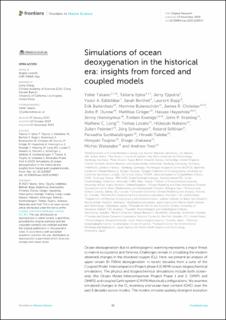| dc.contributor.author | Takano, Yohei | |
| dc.contributor.author | Ilyina, Tatiana | |
| dc.contributor.author | Tjiputra, Jerry | |
| dc.contributor.author | Eddebbar, Yassir A. | |
| dc.contributor.author | Berthet, Sarah | |
| dc.contributor.author | Bopp, Laurent | |
| dc.contributor.author | Buitenhuis, Erik | |
| dc.contributor.author | Butenschön, Momme | |
| dc.contributor.author | Christian, James R. | |
| dc.contributor.author | Dunne, John P. | |
| dc.contributor.author | Gröger, Matthias | |
| dc.contributor.author | Hayashida, Hakase | |
| dc.contributor.author | Hieronymus, Jenny | |
| dc.contributor.author | Koenigk, Torben | |
| dc.contributor.author | Krasting, John P. | |
| dc.contributor.author | Long, Mathew C. | |
| dc.contributor.author | Lovato, Tomas | |
| dc.contributor.author | Nakano, Hideyuki | |
| dc.contributor.author | Palmieri, Julien | |
| dc.contributor.author | Schwinger, Jörg | |
| dc.contributor.author | Séférian, Roland | |
| dc.contributor.author | Suntharalingam, Parvadha | |
| dc.contributor.author | Tatebe, Hiroaki | |
| dc.contributor.author | Tsujino, Hiroyuki | |
| dc.contributor.author | Urakawa, Shogo | |
| dc.contributor.author | Watanabe, Michio | |
| dc.contributor.author | Yool, Andrew | |
| dc.date.accessioned | 2023-11-24T11:50:47Z | |
| dc.date.available | 2023-11-24T11:50:47Z | |
| dc.date.created | 2023-11-15T14:22:32Z | |
| dc.date.issued | 2023 | |
| dc.identifier.citation | Frontiers in Marine Science. 2023, 10 . | en_US |
| dc.identifier.issn | 2296-7745 | |
| dc.identifier.uri | https://hdl.handle.net/11250/3104530 | |
| dc.description.abstract | Ocean deoxygenation due to anthropogenic warming represents a major threat to marine ecosystems and fisheries. Challenges remain in simulating the modern observed changes in the dissolved oxygen (O2). Here, we present an analysis of upper ocean (0-700m) deoxygenation in recent decades from a suite of the Coupled Model Intercomparison Project phase 6 (CMIP6) ocean biogeochemical simulations. The physics and biogeochemical simulations include both ocean-only (the Ocean Model Intercomparison Project Phase 1 and 2, OMIP1 and OMIP2) and coupled Earth system (CMIP6 Historical) configurations. We examine simulated changes in the O2 inventory and ocean heat content (OHC) over the past 5 decades across models. The models simulate spatially divergent evolution of O2 trends over the past 5 decades. The trend (multi-model mean and spread) for upper ocean global O2 inventory for each of the MIP simulations over the past 5 decades is 0.03 ± 0.39×1014 [mol/decade] for OMIP1, −0.37 ± 0.15×1014 [mol/decade] for OMIP2, and −1.06 ± 0.68×1014 [mol/decade] for CMIP6 Historical, respectively. The trend in the upper ocean global O2 inventory for the latest observations based on the World Ocean Database 2018 is −0.98×1014 [mol/decade], in line with the CMIP6 Historical multi-model mean, though this recent observations-based trend estimate is weaker than previously reported trends. A comparison across ocean-only simulations from OMIP1 and OMIP2 suggests that differences in atmospheric forcing such as surface wind explain the simulated divergence across configurations in O2 inventory changes. Additionally, a comparison of coupled model simulations from the CMIP6 Historical configuration indicates that differences in background mean states due to differences in spin-up duration and equilibrium states result in substantial differences in the climate change response of O2. Finally, we discuss gaps and uncertainties in both ocean biogeochemical simulations and observations and explore possible future coordinated ocean biogeochemistry simulations to fill in gaps and unravel the mechanisms controlling the O2 changes. | en_US |
| dc.language.iso | eng | en_US |
| dc.rights | Navngivelse 4.0 Internasjonal | * |
| dc.rights.uri | http://creativecommons.org/licenses/by/4.0/deed.no | * |
| dc.title | Simulations of ocean deoxygenation in the historical era: insights from forced and coupled models | en_US |
| dc.title.alternative | Simulations of ocean deoxygenation in the historical era: insights from forced and coupled models | en_US |
| dc.type | Peer reviewed | en_US |
| dc.type | Journal article | en_US |
| dc.rights.holder | © 2023 Takano, Ilyina, Tjiputra, Eddebbar, Berthet, Bopp, Buitenhuis, Butenschön, Christian, Dunne, Gröger, Hayashida, Hieronymus, Koenigk, Krasting, Long, Lovato, Nakano, Palmieri, Schwinger, Séférian, Suntharalingam, Tatebe, Tsujino, Urakawa, Watanabe and Yool | en_US |
| dc.description.version | publishedVersion | en_US |
| cristin.ispublished | true | |
| cristin.fulltext | original | |
| cristin.qualitycode | 1 | |
| dc.identifier.doi | 10.3389/fmars.2023.1139917 | |
| dc.identifier.cristin | 2197143 | |
| dc.source.journal | Frontiers in Marine Science | en_US |
| dc.source.volume | 10 | en_US |
| dc.source.pagenumber | 21 | en_US |
| dc.relation.project | Sigma2: nn9560 | en_US |
| dc.relation.project | Sigma2: ns9560 | en_US |
| dc.relation.project | Norges forskningsråd: 270061 | en_US |

